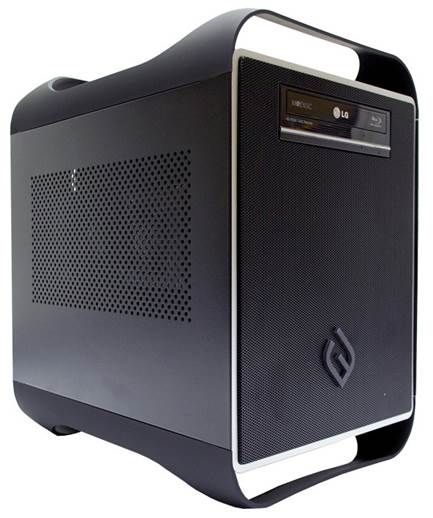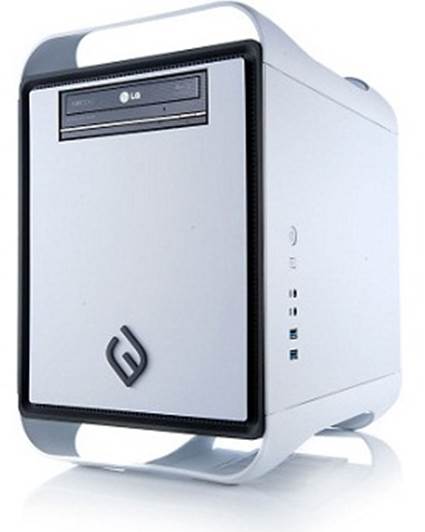THE Enthusiast PC market seems to be
experiencing a bit of bipolar disorder these days. It’s either represented by
massively huge systems so big they blot out the sun, or teeny, tiny boxes that
you could slip under your arm and then skate board to a LAN party.
The V3 Traverse falls into the latter
category. Built in BitFenix’s cool Little Prodigy case, the Traverse is a
kissing cousin to the “Small but Mighty Gaming Rig” from our October 2012 issue
(Build It). Well, except that the Traverse is a full on freedom kiss in the
graphics department. We’ve seen snaps of the BitFenix Prodigy with a dual-GPU
card in it, but we were skeptical until now. The V3 Traverse sports none other
than the fastest card in town: a GeForce GTX 690. Cracking open the Traverse,
we were Literally shocked to see the entire box running on a Corsair CX600 PSU.
Why the amazement? We’re just so used to dual cards sucking up power by the
megawatts that a “mere” 600 watt PSU seemed surprising.

The
V3 Traverse falls into the latter category.
With the GeForce GTX 690 rated to consume
300 watts of juice, that doesn’t leave much for the rest of the system. V3 gets
away with the smaller PSU because the Mini-ITX board and case don’t allow you
to build out to, say, five hard drives and a carload of other accessories.
Still, it’s probably a bit Less headroom than you’d Like, especially on
sweltering days when the temperature in your room is 85 degrees and the temp
inside your case is a balmy 130 degrees or more.
This brings us to a real snag, though. V3
tapped the budget wonder known as Intel’s Core i5-3570K to run this show. The
CPUs temps are controlled by closed-loop Liquid cooling, and it’s overclocked
from the stock 3.4GHz to 4.8GHz. That’s quite a leap for an Ivy Bridge using a
closed-Loop cooler. In our October build, we opted for a more conservative
4.4GHz using a different closed Loop liquid cooler.
Right off the bat, the V3 Traverse coughed
up a BSOD in our Stitch.Efx 2.0 benchmark. V3 advised us to add a little core
voltage and clock it back 100MHz to 4.7GHz and drive on. We did that and
experienced no further stability issues in any of our benchmarks, including
multiple heavily threaded encoding benchmarks. When we finished, though, we decided
to execute a cursory Prime95 Load on the box something we do with all
overclocked machines we review or build. Within 10 minutes, the machine again
blew a BSOD. That’s not good and made us wonder how carefully the company had
vetted the overclock. V3 assured us it had done extensive stress testing before
the box shipped. Obviously, something wasn’t right.

Right
off the bat, the V3 Traverse coughed up a BSOD in our Stitch.Efx 2.0 benchmark.
In performance, the Traverse is no slouch.
Our dataset of systems that have run our new benchmark gauntlet isn’t huge, but
the GeForce GTX 690 is a tough one to beat. In gaming, iin fact, the Traverse
was the second-fastest box we’ve tested, behind our quad-SLI Dream Machine. The
compute-bound tests also saw the Traverse with pretty respectable scores, for a
non-Hyper-Threaded processor. To put some perspective on Hyper-Threading’s
value in multi-threaded tasks, the miniature Polywell we reviewed in October,
with its stock clocked 3.4GHz Core i7-3770, is damn near as fast the 4.7GHz
Traverse in our Premiere Pro CS6 test, and faster in the x264video encode test.
In workloads that can’t Load up the processor, however, the Traverse’s high
clocks put it well ahead of the diminutive Polywell.
Our real issue is the instability. We can
accept having to tune the box down one time, but a spontaneous reboot within 10
minutes of a Prime95 Load after applying the recommended fix is a pretty big
negative. For what it’s worth, we clocked down to 4.6GHz and ran Prime95 for an
hour with no issue. Obviously, if the box were stable out of the box, we’d
recommend it, but our experience was less than satisfactory.